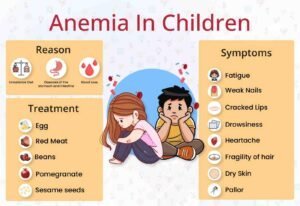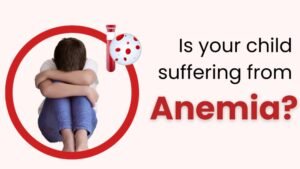Symptoms of Anemia in Children
Anemia is a common condition in children, marked by a deficiency of red blood cells or hemoglobin in the blood. Recognizing its symptoms early is essential for timely diagnosis and treatment. Some primary symptoms include:
- Fatigue and Weakness
Children with anemia may feel tired even after adequate rest. They often show reduced energy, lethargy, and may struggle to keep up with peers during physical activities. - Pale Skin and Mucous Membranes
Anemia may cause paleness, especially noticeable on the face, lips, inside the lower eyelids, and nail beds. This is due to the decreased oxygen-carrying capacity from low hemoglobin levels. - Shortness of Breath
Children with anemia may experience shortness of breath, even during minimal exertion, due to insufficient oxygen supply to tissues and organs. - Rapid Heart Rate or Palpitations
Anemia forces the heart to work harder to pump oxygen-rich blood throughout the body, potentially causing a faster or irregular heartbeat.

Parents should also watch for signs such as dizziness, headaches, cold hands and feet, chest pain, poor appetite, irritability, and delayed growth or development, as these could indicate anemia.
Blood Tests for Diagnosing Anemia
Blood tests are critical for diagnosing anemia in children. Common tests include:
- Complete Blood Count (CBC)
A CBC provides essential information on red blood cell count, hemoglobin levels, hematocrit levels, and mean corpuscular volume (MCV). This test can highlight abnormalities indicative of anemia. - Peripheral Blood Smear
In some cases, a peripheral blood smear allows for a detailed view of red blood cell size, shape, and appearance, aiding in the diagnosis of specific types of anemia, like thalassemia or sickle cell disease. - Iron Studies
Iron studies measure serum ferritin, serum iron levels, total iron-binding capacity (TIBC), and transferrin saturation. Low serum ferritin and hemoglobin, paired with high TIBC, often indicate iron deficiency anemia. These tests help healthcare providers tailor treatment strategies for specific deficiencies.

Types of Anemia in Children
Anemia in children can present in different forms, each with unique causes and mechanisms. Common types include:
- Iron-Deficiency Anemia
This type occurs when there’s not enough iron to produce hemoglobin. Causes can include inadequate dietary iron or poor absorption. Children who consume low amounts of heme iron, found in foods like red meat, or those with absorption issues, like celiac disease, are at higher risk. - Hemolytic Anemia
Hemolytic anemia results from the rapid destruction of red blood cells. It can be inherited or acquired through autoimmune disorders, infections, medications, or toxins. Symptoms may include fatigue, jaundice, and dark urine. - Sickle Cell Anemia
Sickle cell anemia is a genetic disorder affecting hemoglobin production, causing red blood cells to become sickle-shaped and block blood flow. Common among children of African descent, it leads to pain crises and potential organ damage. Management includes monitoring, hydration, pain management, and sometimes blood transfusions.
Understanding these types of anemia aids healthcare providers in accurately diagnosing and managing the condition, tailoring interventions to address specific causes and improve quality of life.
Treating Anemia in Children
After diagnosing anemia, the next step is treatment, which varies based on the type and severity of anemia.
- Dietary Modifications and Supplements
For iron deficiency anemia, increasing iron intake through foods like red meat, poultry, fish, fortified cereals, beans, and leafy greens is beneficial. If dietary changes are insufficient, healthcare providers may prescribe iron supplements. - Intravenous (IV) Iron Therapy
For severe cases or those with absorption issues, IV iron therapy can deliver concentrated iron directly to the bloodstream, bypassing gastrointestinal side effects of oral supplements. - Treating Underlying Conditions
Addressing medical conditions like chronic illnesses that impact red blood cell production is vital. For example, treating inflammatory disorders or kidney disease can help improve hemoglobin levels over time.
Effective management often involves a team of healthcare professionals, including pediatricians, hematologists, and dietitians, who create comprehensive treatment plans tailored to each child’s needs.
Related Conditions
Several related conditions can impact children with anemia:
- Iron Deficiency
Often coexisting with anemia, iron deficiency impairs hemoglobin production, leading to reduced oxygen-carrying capacity. Addressing iron deficiency early helps prevent complications. - Vitamin B12 Deficiency
A lack of vitamin B12 affects red blood cell production, leading to megaloblastic anemia, which can cause fatigue and neurological symptoms like tingling in the hands and feet. - Chronic Illnesses
Conditions like inflammatory bowel disease or chronic kidney disease can interfere with nutrient absorption or erythropoietin production, a hormone crucial for red blood cell production. Managing these conditions can reduce anemia symptoms.
Identifying and addressing these related conditions alongside anemia enables healthcare providers to offer holistic care and optimize treatment outcomes.
Conclusion
Diagnosing anemia in children is essential for their health and well-being. Recognizing symptoms, understanding blood tests, differentiating types of anemia, and exploring treatment options help healthcare providers effectively manage pediatric anemia. By working closely with healthcare professionals, parents can ensure their child receives proper care and monitoring.
With early detection and appropriate management, children with anemia can lead healthy lives. Although a diagnosis of anemia may initially be concerning, most cases are manageable with medical care and lifestyle adjustments. Staying informed and proactive empowers families to confidently navigate anemia in children.